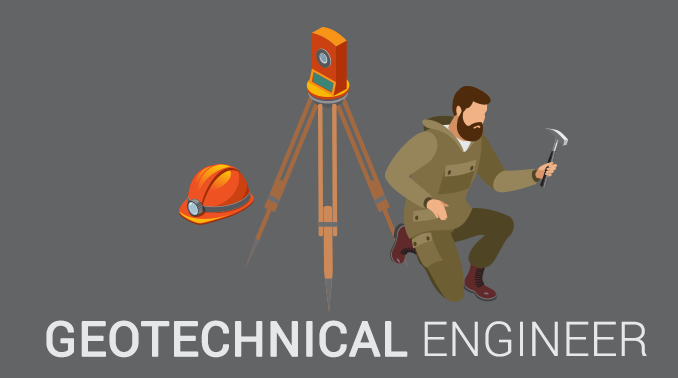The Ultimate Guide To Geotheta
The Ultimate Guide To Geotheta
Blog Article
Some Of Geotheta
Table of ContentsThe Greatest Guide To GeothetaEverything about GeothetaGeotheta Things To Know Before You Get ThisExcitement About GeothetaThe Single Strategy To Use For Geotheta

They perform website investigations, accumulate examples, perform laboratory examinations, and examine information to evaluate the suitability of the ground for building and construction tasks - Tailings Engineer. Based upon their findings, geotechnical engineers give suggestions for structure style, slope stability, keeping structures, and mitigation of geotechnical dangers. They work together with various other professionals, such as engineers, architectural designers, and building and construction groups, to make sure that geotechnical factors to consider are integrated right into the overall job layout and implementation
By assessing the behavior and properties of dirt and rock, they can recognize prospective geotechnical hazards such as landslides, dirt settlement, or incline instability. Their expertise assists stop failures or mishaps that could endanger lives and property. Here are some thorough duties and duties of a geotechnical designer: Website Investigation: Geotechnical designers conduct site examinations to collect data on subsurface conditions.
They analyze the data to recognize the residential properties and habits of the soil and rock, including their stamina, permeability, compaction features, and groundwater problems. Geotechnical Analysis and Style: Geotechnical designers analyze the data collected throughout website examinations to examine the stability and suitability of the site for building and construction projects. They execute geotechnical estimations and modeling to review elements such as birthing ability, settlement, incline stability, side planet pressures, and groundwater flow.
The Best Guide To Geotheta
Structure Design: Geotechnical designers play a critical role in creating foundations that can securely sustain the intended structure. They examine the soil conditions and lots needs to identify the appropriate structure kind, such as shallow structures (e.g., grounds), deep foundations (e.g (https://justpaste.it/ec966)., heaps), or specialized methods like soil renovation. They think about elements such as settlement limitations, birthing capacity, and soil-structure communication to establish ideal structure designs
They examine building strategies, monitor website tasks, and conduct area evaluations to validate that the style suggestions are complied with. If unexpected geotechnical problems develop, they evaluate the situation and provide recommendations for remediation or adjustments to the style. Danger Analysis and Reduction: Geotechnical designers analyze geotechnical dangers and dangers related to the job site, such as landslides, liquefaction, or soil disintegration.

Cooperation and Communication: Geotechnical designers function very closely with other experts entailed in a task, such as engineers, architectural engineers, and building and construction teams. Reliable interaction and collaboration are essential to incorporate geotechnical considerations right into the general job style and building and construction process. Geotechnical designers provide technical proficiency, response queries, and make sure that geotechnical demands are met.
The Buzz on Geotheta
Below are some types of geotechnical engineers: Structure Designer: Foundation engineers focus on making and assessing structures for frameworks. They evaluate the dirt problems, lots demands, and website characteristics to identify one of the most proper structure kind and style, such as shallow structures, deep structures, or specialized techniques like pile foundations.
They examine the aspects influencing slope security, such as soil homes, groundwater conditions, and slope geometry, and develop methods to stop slope failings and reduce threats. Quake Engineer: Quake engineers focus on examining and creating structures to stand up to seismic pressures. They evaluate the seismic risk of a site, evaluate dirt liquefaction possibility, and create seismic layout criteria to make certain the security and durability of frameworks during earthquakes.
They carry out area screening, collect samples, and evaluate the collected data to define the dirt homes, geologic formations, and groundwater conditions at a website. Geotechnical Instrumentation Designer: Geotechnical instrumentation designers concentrate on surveillance and measuring the actions of soil, rock, and frameworks. They install and maintain instrumentation systems that keep an eye on factors such as soil negotiation, groundwater levels, slope activities, and structural displacements to assess performance and offer early warnings of prospective issues.
Not known Incorrect Statements About Geotheta
They conduct tests such as triaxial tests, loan consolidation tests, straight shear examinations, and permeability examinations to collect data for geotechnical analysis and design. Geosynthetics Designer: Geosynthetics engineers official source focus on the layout and application of geosynthetic materials, such as geotextiles, geogrids, and geomembranes. They make use of these materials to boost dirt stability, enhance slopes, offer drain remedies, and control disintegration.
They tend to be investigatory individuals, which indicates they're intellectual, introspective, and curious. They are interested, methodical, reasonable, logical, and sensible. Some of them are also social, implying they're kind, generous, cooperative, person, caring, practical, compassionate, tactful, and pleasant - Geo Tech Engineering.
In the workplace environment, geotechnical designers use specialized software devices to carry out estimations, produce styles, and assess information. They prepare reports, evaluation task requirements, interact with clients and team participants, and coordinate task tasks. The workplace setting provides a favorable setting for research study, evaluation, and partnership with various other experts included in the task.
Some Of Geotheta
They often visit project sites to perform website investigations, examine geotechnical conditions, and gather data for analysis. These brows through involve traveling to different areas, sometimes in remote or difficult terrains. Geotechnical engineers might carry out soil sampling, conduct tests, and monitor building and construction activities to make certain that the geotechnical facets of the project are being executed properly.
Geotechnical engineers additionally work in specialized geotechnical labs. Geotechnical research laboratory designers work extensively in these atmospheres, dealing with screening devices, operating tools, and taping data.
Report this page